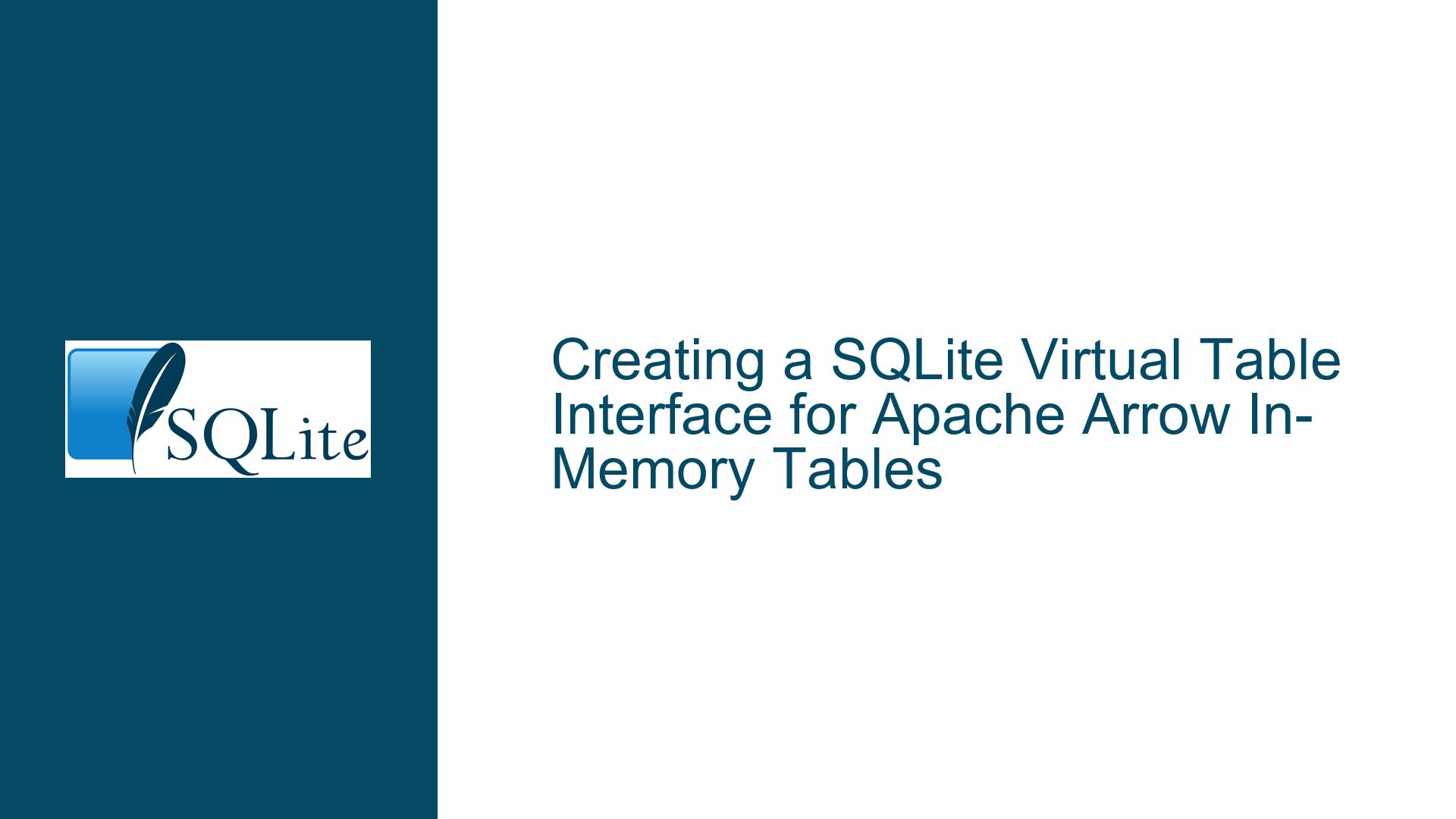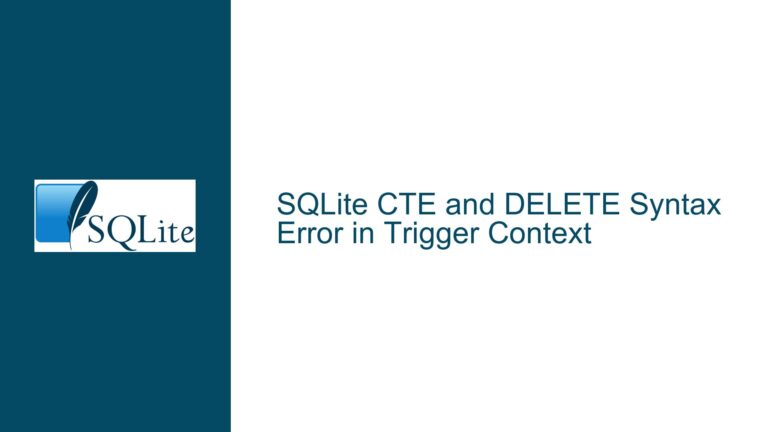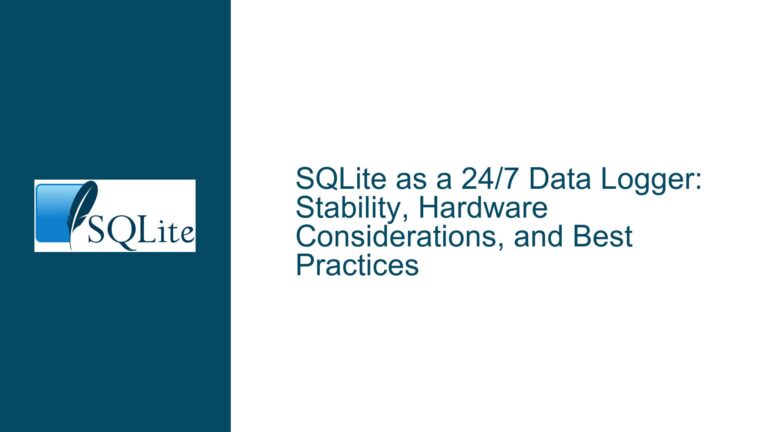Creating a SQLite Virtual Table Interface for Apache Arrow In-Memory Tables
Integrating SQLite Virtual Tables with Apache Arrow In-Memory Data Structures
Challenge: Bridging Row-Based and Columnar Data Models
The core challenge lies in creating a SQLite virtual table interface that directly interacts with Apache Arrow’s in-memory columnar data structures. SQLite’s virtual table API is designed to map relational, row-oriented data into queryable tables. Apache Arrow, however, stores data in a columnar format optimized for analytical workloads, which introduces structural and operational mismatches.
A virtual table implementation must reconcile these differences by translating SQLite’s row-centric operations (e.g., xFilter, xNext) into Arrow’s columnar data access patterns. This requires iterating over Arrow arrays column-wise while presenting rows to SQLite’s query engine. Additionally, Apache Arrow tables are often immutable, simplifying transactional guarantees but complicating write operations if required. Existing solutions like the Parquet virtual table extension operate on file-based storage and bypass Arrow’s in-memory structures, making them unsuitable for direct integration.
The absence of prior work in this area suggests inherent complexities, such as memory ownership, data type conversions, and performance overheads. For example, Arrow’s support for complex data types (e.g., nested lists, timestamps with time zones) may not map cleanly to SQLite’s type system. Furthermore, virtual tables must handle Arrow’s memory buffers safely, ensuring they remain valid throughout query execution.
Root Causes of Integration Hurdles
1. Structural Mismatch Between Row and Columnar Formats
SQLite’s virtual table API assumes a row-oriented data model, where rows are accessed sequentially via cursor-based iteration. Apache Arrow, in contrast, organizes data into columns, with each column stored as a contiguous buffer. Translating columnar data into rows requires assembling individual values from multiple columns into a single row representation during query execution. This introduces computational overhead, particularly for large datasets, as every row materialization involves dereferencing multiple column buffers.
2. Immutable Data and Transactional Limitations
Apache Arrow in-memory tables are frequently immutable to enable lock-free concurrent reads. While this simplifies read-only access, it conflicts with SQLite’s transactional model, which assumes the ability to modify data through INSERT, UPDATE, or DELETE operations. A virtual table implementation targeting immutable Arrow tables would need to disable or emulate write operations, potentially limiting SQL functionality.
3. Lack of Native Arrow Integration in SQLite Extensions
Existing SQLite extensions for Parquet or other columnar formats often bypass Arrow’s memory structures to avoid dependencies on Arrow’s C/C++ libraries. For instance, the Parquet virtual table extension interacts directly with Parquet files using the Parquet C++ API, bypassing Arrow’s in-memory representation. This design choice minimizes memory usage but leaves Arrow tables unaddressed.
4. Data Type Compatibility and Conversion
Apache Arrow supports a richer set of data types compared to SQLite. For example, Arrow’s TIMESTAMP type includes nanosecond precision and time zone metadata, while SQLite’s DATETIME type is stored as a string or numeric value without inherent time zone support. Converting these types requires careful handling to prevent data loss or misinterpretation. Similarly, Arrow’s nested types (e.g., List, Struct) lack direct equivalents in SQLite, necessitating serialization or flattening strategies.
5. Memory Management and Lifetime Guarantees
Arrow in-memory tables rely on reference-counted buffers to manage ownership. A virtual table implementation must ensure that these buffers remain valid throughout query execution. SQLite’s virtual table lifecycle—where tables can be opened, closed, and reused across connections—introduces challenges in coordinating buffer lifetimes with SQLite’s transactional boundaries.
Strategies for Implementation and Optimization
1. Leveraging the Arrow C Data Interface
The Arrow C Data Interface provides a stable ABI for exchanging Arrow data between libraries without direct dependencies. A virtual table implementation can use this interface to access Arrow arrays without linking against Arrow’s C++ libraries, reducing compatibility risks. For example:
// Pseudocode for accessing an Arrow array via the C Data Interface
struct ArrowArray* arrow_array = ...;
struct ArrowSchema* arrow_schema = ...;
// Use arrow_array->buffers to access column data
This approach decouples the virtual table from Arrow’s implementation details, allowing it to work with any Arrow-compatible library.
2. Row Materialization Techniques
To bridge the row-columnar divide, the virtual table can materialize rows on demand during cursor iteration. For each xNext call, the cursor advances to the next row index and extracts values from each Arrow column’s buffer:
// Pseudocode for row materialization
static int vt_next(sqlite3_vtab_cursor* cursor) {
VTCursor* vt_cursor = (VTCursor*)cursor;
vt_cursor->current_row++;
return SQLITE_OK;
}
static int vt_column(
sqlite3_vtab_cursor* cursor,
sqlite3_context* ctx,
int col_idx
) {
VTCursor* vt_cursor = (VTCursor*)cursor;
ArrowArray* column = vt_cursor->columns[col_idx];
// Extract value from column->buffers at vt_cursor->current_row
sqlite3_result_text(ctx, value, -1, SQLITE_TRANSIENT);
return SQLITE_OK;
}
This method minimizes memory usage by avoiding pre-materializing the entire table but incurs overhead per-row access.
3. Batch Processing for Performance Optimization
For analytical queries scanning large ranges, batch processing can reduce per-row overhead. The virtual table can expose a xBestIndex method that prefers full-table scans and leverages Arrow’s columnar batch processing:
// Pseudocode for batch filtering
static int vt_filter(
sqlite3_vtab_cursor* cursor,
int idxNum, const char* idxStr,
int argc, sqlite3_value** argv
) {
VTCursor* vt_cursor = (VTCursor*)cursor;
vt_cursor->current_row = 0;
// Apply batch filters using Arrow Compute API
arrow_compute_filter(vt_cursor->arrow_table, idxStr);
return SQLITE_OK;
}
4. Handling Immutable Data and Write Operations
If the Arrow table is immutable, the virtual table should explicitly declare itself as read-only by setting SQLITE_VTAB_READONLY in xConnect/xCreate. Attempts to modify data via INSERT or UPDATE will then return SQLITE_READONLY errors. For write support, the virtual table could implement copy-on-write semantics by creating a mutable copy of the Arrow data, though this diverges from Arrow’s typical usage.
5. Type Mapping and Conversion Tables
Define a conversion table between Arrow data types and SQLite’s type affinities:
| Arrow Type | SQLite Type | Conversion Notes |
|---|---|---|
Int32 | INTEGER | Direct copy. |
Float64 | REAL | Direct copy. |
String | TEXT | UTF-8 validation required. |
Timestamp(Nanosecond, UTC) | TEXT | ISO 8601 string with nanosecond precision. |
List<Int32> | TEXT | JSON serialization: "[1, 2, 3]". |
Implement type-specific conversion functions in the xColumn method to handle these mappings.
6. Memory Management and Buffer Lifetimes
Use SQLite’s xDestroy method to release references to Arrow arrays when the virtual table is disconnected. If the Arrow data is owned by another component, the virtual table should increment the buffer’s reference count upon initialization and decrement it during cleanup:
static int vt_disconnect(sqlite3_vtab* vtab) {
VTable* vt = (VTable*)vtab;
for (int i = 0; i < vt->num_columns; i++) {
vt->arrow_arrays[i].release(&vt->arrow_arrays[i]);
}
sqlite3_free(vt);
return SQLITE_OK;
}
7. Query Optimization and Pushdown
To avoid full-table scans, implement predicate pushdown using the xBestIndex method. Parse SQLite’s query constraints into Arrow-compatible expressions and apply them using Arrow’s Compute API:
static int vt_best_index(
sqlite3_vtab* vtab,
sqlite3_index_info* info
) {
// Identify usable constraints and construct an Arrow filter expression
for (int i = 0; i < info->nConstraint; i++) {
if (info->aConstraint[i].usable) {
// Map SQLite column index to Arrow column
// Build filter expression
}
}
info->idxNum = ...; // Identifier for the chosen filter
return SQLITE_OK;
}
8. Testing and Validation
Validate the implementation using Arrow’s testing framework and SQLite’s sqllogictest. Key test cases include:
- Correct type conversion across all supported data types.
- Handling of NULL values in Arrow columns.
- Performance benchmarks comparing direct Arrow access versus SQLite queries.
- Memory leak detection using tools like Valgrind or ASan.
9. Open-Sourcing and Community Engagement
Publish the virtual table extension under a permissive license (e.g., MIT or Apache 2.0) to encourage collaboration. Engage with the Arrow and SQLite communities to gather feedback and contributions. Document the extension’s limitations, such as read-only access or type conversion caveats, to set user expectations.
10. Alternatives and Workarounds
If building a custom virtual table proves infeasible, consider these alternatives:
- Arrow to SQLite In-Memory Import: Convert Arrow tables to SQLite in-memory tables using batch inserts. This sacrifices query flexibility for simplicity.
- Hybrid Queries: Use Arrow’s built-in compute functions for performance-critical operations and SQLite for complex joins or ad-hoc queries.
By systematically addressing structural mismatches, optimizing data access patterns, and rigorously validating the implementation, developers can create a robust SQLite virtual table interface for Apache Arrow in-memory tables, enabling flexible SQL queries on high-performance columnar data.






